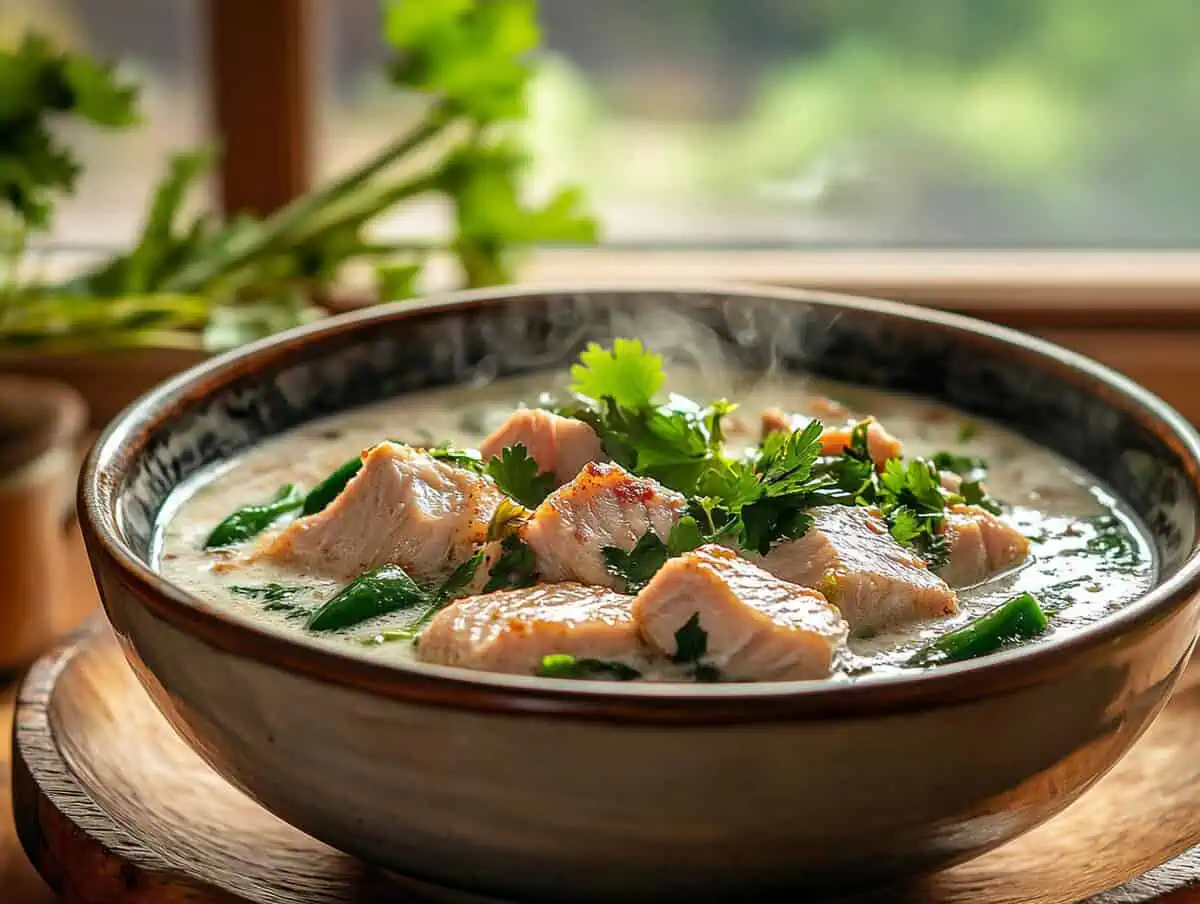Welcome to my kitchen's favorite tuna dish! This Ginataang Tambakol recipe combines tender chunks of yellowfin tuna simmered in rich coconut milk with aromatic spices and fresh vegetables. After years of perfecting this traditional Filipino dish from the Bicol region, I'm excited to share my foolproof method that delivers restaurant-quality results every time.
The combination of lightly fried fish that soaks up the creamy coconut sauce, punctuated with gentle heat from green chilies, creates an incredibly satisfying meal that's ready in under an hour.
Whether you're new to Filipino cooking or looking to expand your recipe collection, this dish will transport your taste buds to the tropical islands with its perfect balance of savory, creamy, and subtly spicy flavors. Grab your pan and let's create this simple yet impressive dish.
What is Tambakol?
Tambakol, known in English as yellowfin tuna, is a saltwater fish recognizable by its distinctive stripes on its back and deeply forked tail. It's also commonly called mackerel tuna or skipjack tuna in some regions. In Filipino markets, you might find it labeled as tulingan, barilis, or talingay.
This fish has a tender, flavorful flesh with a fresh ocean taste that pairs beautifully with coconut milk. While tambakol can be prepared in many ways (paksiw, sinaing, or as tuna steak), the ginataan method brings out its natural sweetness while infusing it with aromatic spices.
Jump to:
Why You'll Love This Recipe
Ginataang Tambakol is a delicious Filipino dish that brings together the rich flavors of fresh yellowfin tuna and creamy coconut milk in perfect harmony. This authentic Bicolano recipe offers a beautiful balance of savory, spicy, and creamy notes that will transform your dinner into a memorable feast.
The tender fish absorbs the aromatic coconut sauce, creating a dish that's both comforting and exciting. If you love dishes with depth of flavor that come together easily, this Filipino classic is sure to become a regular in your kitchen!
Ingredients
I've carefully selected these ingredients to create authentic Bicolano flavors in every bite. The yellowfin tuna provides a meaty base that holds up beautifully to both frying and simmering, while absorbing the rich coconut milk, the star ingredient that gives this dish its signature creaminess.
Fresh aromatics like ginger, garlic, and onions build a fragrant foundation, while tomatoes add natural sweetness and acidity that balances the richness. Green chilies bring that characteristic Bicolano gentle heat without overwhelming the dish.
The pechay leaves aren't just for color, they add a fresh, slightly bitter note that cuts through the creamy sauce and completes this perfectly balanced, nutritious meal.\

- ½ kilo (about 1 lb) tambakol (yellowfin tuna), sliced into serving pieces
- 2 cups coconut milk, preferably fresh
- 1 bunch pechay or mustard leaves, chopped
- 1 medium onion, finely chopped
- 3 cloves of garlic, minced
- 1 thumb-sized ginger, peeled and minced
- 2 medium tomatoes, diced
- 3-4 green chilies, kept whole
- Salt and pepper to taste
- Fish sauce to taste
- 2 tablespoons cooking oil for frying
Equipment
- Sharp knife - For cutting the fish into serving pieces and chopping vegetables
- Heavy-bottomed pan or skillet - Provides even heating for both frying and simmering
- Cutting board - For preparing all ingredients
- Measuring cups - For accurately measuring the coconut milk
- Wooden spoon - For gentle stirring without breaking the fish
- Serving platter - For presenting the finished dish

How To Make
- Season the fish: Massage the tambakol pieces with salt and pepper and let them marinate for at least 15 minutes to enhance flavor and reduce splattering when frying.
- Fry the fish: Heat oil in a pan over medium heat and fry the tambakol pieces until half-cooked, about 2-3 minutes per side. Remove the fish from the pan and set aside.
- Create the flavor base: In the same pan with the remaining oil, sauté the onions, garlic, and ginger until fragrant and soft, about 2 minutes. Add the diced tomatoes and gently crush them with your spoon to release their juices and flavor.
- Prepare the coconut sauce: Pour in the coconut milk and add the whole green chilies. Bring to a gentle boil over low heat. Season with pepper and fish sauce to taste. Simmer for 5-7 minutes until the sauce begins to thicken.
- Combine with fish: Return the fried fish to the pan and simmer for 5-7 minutes until the sauce is reduced and the fish is fully cooked.
- Add greens: Stir in the chopped pechay or mustard leaves and cook just until slightly wilted, about 1-2 minutes.
- Serve: Transfer the ginataang tambakol to a serving plate and enjoy with steaming hot rice.

Tips from Lola's Kitchen
- Fresh coconut milk makes all the difference - While convenient, powdered coconut milk mixes can't compare to freshly pressed coconut cream. If possible, buy fresh from the market or prepare it at home.
- Don't overcook the fish - Tuna can become dry if cooked too long. The two-step cooking process (frying then simmering) helps keep the fish moist while developing flavor.
- Control the heat - When adding coconut milk, keep the heat low to prevent curdling.
- Adjust spice levels - For extra heat, add chopped red chilies along with the green ones, or remove the seeds from the chilies for a milder flavor.
- Let the flavors develop - Like many Filipino dishes, Ginataang Tambakol often tastes even better the next day when the flavors have had time to meld.
Substitutions
- Fish options: If tambakol isn't available, you can use other firm fish like mackerel (tanigue), mahi-mahi, or even salmon.
- Leafy greens: Spinach, bok choy, or kale can replace pechay or mustard leaves.
- Coconut milk: In a pinch, you can use canned coconut milk, but try to find one without additives or preservatives.
- Chilies: If green chilies aren't available, use jalapeños or serrano peppers as alternatives.
- Fish sauce: Soy sauce with a pinch of salt can substitute for fish sauce if needed.
Troubleshooting
- Sauce is too thin: Continue simmering uncovered to reduce the sauce. If needed, you can add a small amount of cornstarch slurry (1 teaspoon cornstarch mixed with 1 tablespoon water).
- Fish is breaking apart: This usually happens if the fish is overcooked or stirred too vigorously. Handle the fish gently and avoid overcooking.
- Coconut milk is curdling: This happens when cooked at too high a temperature. Always simmer coconut milk on low heat.
- Not spicy enough: Add a few teaspoons of red pepper flakes or a dash of hot sauce.
- Too spicy: Add more coconut milk to dilute the heat, or serve with extra rice.
Storage & Reheating
- Refrigeration: Store leftovers in an airtight container for up to 2 days. The flavors often develop more fully overnight.
- Freezing: While possible, freezing isn't recommended as the texture of the fish and sauce may change upon thawing.
- Reheating: Gently warm over low heat on the stovetop. Add a splash of coconut milk if the sauce has thickened too much during storage. Avoid microwave reheating as it can make the fish tough.

FAQ
What does "ginataan" mean?
"Ginataan" comes from the Tagalog word "gata" meaning coconut milk. It refers to any Filipino dish cooked with coconut milk.
Is this dish spicy?
It has a moderate level of spice from the green chilies. You can adjust the heat level by adding more chilies or removing their seeds for a milder version.
Can I use canned tuna for this recipe?
Fresh tuna is strongly recommended for this dish. Canned tuna has a different texture and flavor profile that won't give you the authentic experience.
Why fry the fish first instead of just cooking it in the coconut milk?
Frying the fish first creates better flavor through caramelization and helps the fish maintain its shape during simmering.
Is this dish keto-friendly?
Yes! With its high-fat content from coconut milk and protein from tuna, this dish fits well into a ketogenic diet if you omit serving it with rice.
What region of the Philippines is this dish from?
Ginataang Tambakol originates from the Bicol region, which is famous for its coconut-based dishes with a spicy kick.
Related
Looking for other recipes like this? Try these:

Ginataang Tambakol (Filipino Tuna in Coconut Milk)
Ingredients
- ½ kilo about 1 lb tambakol (yellowfin tuna), sliced into serving pieces
- 2 cups coconut milk preferably fresh
- 1 bunch pechay or mustard leaves chopped
- 1 medium onion finely chopped
- 3 cloves of garlic minced
- 1 thumb-sized ginger peeled and minced
- 2 medium tomatoes diced
- 3-4 green chilies kept whole
- Salt and pepper to taste
- Fish sauce to taste
- 2 tablespoons cooking oil for frying
Instructions
- Season the fish: Massage the tambakol pieces with salt and pepper and let them marinate for at least 15 minutes to enhance flavor and reduce splattering when frying.
- Fry the fish: Heat oil in a pan over medium heat and fry the tambakol pieces until half-cooked, about 2-3 minutes per side. Remove the fish from the pan and set aside.
- Create the flavor base: In the same pan with the remaining oil, sauté the onions, garlic, and ginger until fragrant and soft, about 2 minutes. Add the diced tomatoes and gently crush them with your spoon to release their juices and flavor.
- Prepare the coconut sauce: Pour in the coconut milk and add the whole green chilies. Bring to a gentle boil over low heat. Season with pepper and fish sauce to taste. Simmer for 5-7 minutes until the sauce begins to thicken.
- Combine with fish: Return the fried fish to the pan and simmer for 5-7 minutes until the sauce is reduced and the fish is fully cooked.
- Add greens: Stir in the chopped pechay or mustard leaves and cook just until slightly wilted, about 1-2 minutes.
- Serve: Transfer the ginataang tambakol to a serving plate and enjoy with steaming hot rice.
Tips from Lola's Kitchen
- Fresh coconut milk makes all the difference - While convenient, powdered coconut milk mixes can't compare to freshly pressed coconut cream. If possible, buy fresh from the market or prepare it at home.
- Don't overcook the fish - Tuna can become dry if cooked too long. The two-step cooking process (frying then simmering) helps keep the fish moist while developing flavor.
- Control the heat - When adding coconut milk, keep the heat low to prevent curdling.
- Adjust spice levels - For extra heat, add chopped red chilies along with the green ones, or remove the seeds from the chilies for a milder flavor.
- Let the flavors develop - Like many Filipino dishes, Ginataang Tambakol often tastes even better the next day when the flavors have had time to meld.
The Story Behind Ginataang Tambakol
Ginataang Tambakol holds a special place in Filipino cuisine, particularly in the vibrant culinary landscape of the Bicol Region. This delicious dish showcases the ingenious way Filipinos have historically combined local ingredients to create flavors that are both comforting and distinctive. The recipe represents centuries of cultural development and adaptation to the abundant natural resources of the Philippine archipelago.
The origins of Ginataang Tambakol can be traced back to the coastal communities of Bicol, where fishing has been a primary livelihood for generations. With its volcanic soil and tropical climate, the Bicol Region is blessed with both bountiful seas and flourishing coconut plantations, creating the perfect environment for this dish to emerge. Local fishermen would bring home their fresh catch of yellowfin tuna, and families would prepare it using the coconut milk readily available from the trees that dot the landscape.
What makes Bicolano cuisine stand out in Philippine culinary traditions is its characteristic use of coconut milk combined with chili peppers. This flavor combination reflects the region's agricultural abundance and the people's preference for dishes with a spicy kick. While many Filipino dishes use coconut milk, it's the Bicolano tradition of adding heat from various chilies that gives Ginataang Tambakol its distinctive character.
The cooking method itself tells a story of practical wisdom. By frying the fish first before simmering it in coconut milk, Bicolano cooks discovered a technique that preserves the fish's texture while allowing it to absorb the creamy sauce. This two-step cooking process demonstrates how traditional knowledge evolved to address specific culinary challenges, such as preventing delicate fish from breaking apart during the long cooking process.
As Filipino migrants traveled throughout the country and abroad, they brought this recipe with them, adapting it to available ingredients while maintaining its essential character. Today, you'll find variations of Ginataang Tambakol across the Philippines, with each region adding its own subtle twist to the basic combination of fish, coconut milk, and spices.
The dish also reflects the Filipino value of resourcefulness. Nothing goes to waste in traditional cooking, and Ginataang Tambakol exemplifies this by using every part of the coconut (milk for the sauce) and incorporating vegetables like pechay that might be growing in the home garden. This approach to cooking—using what's fresh, local, and abundant—connects modern cooks to sustainable practices that have been part of Filipino culture for centuries.
In recent years, as interest in authentic global cuisines has grown, Ginataang Tambakol has gained recognition beyond Filipino communities. Culinary enthusiasts appreciate its perfect balance of protein, healthy fats from coconut milk, and fresh vegetables—aligning well with contemporary interest in nutritious, whole-food cooking. The dish offers a window into Filipino food culture that values depth of flavor without relying on complicated techniques or hard-to-find ingredients.
Whether enjoyed in a humble kitchen in the Bicol Region or prepared by Filipino families maintaining their cultural heritage abroad, Ginataang Tambakol continues to tell the story of a cuisine that masterfully blends simplicity with flavor, tradition with practicality, and local bounty with culinary creativity.










Comments
No Comments